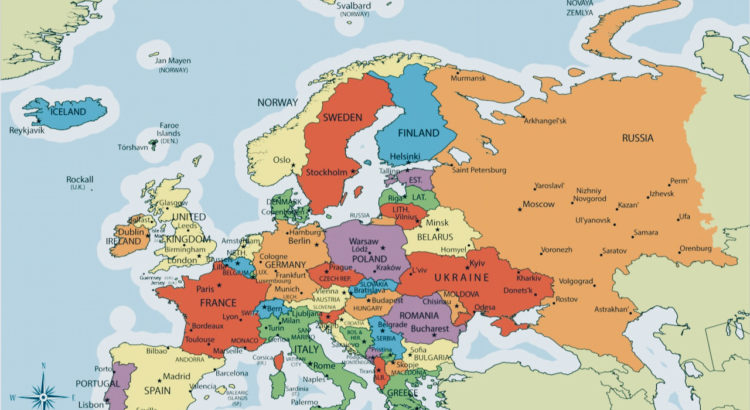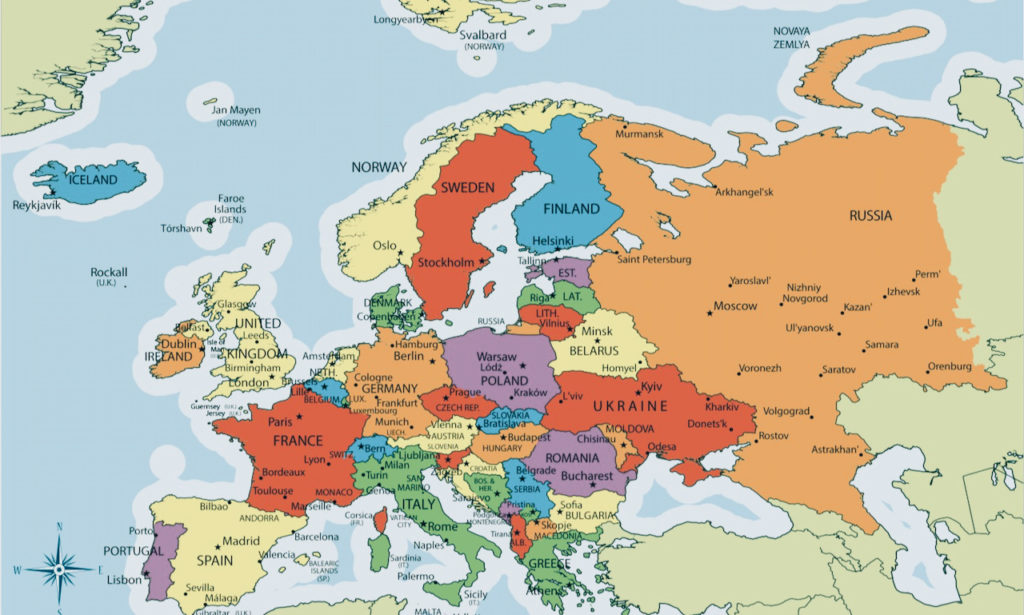
Geographical differences more significant than differences in vaccinations
There have been marked differences between the covid trajectories in Eastern and Western Europe; in particular Spring 2020, Spring 2021 and Autumn 2021 showed markedly different death rates (from covid). The low death rate in the UK in Spring 2021 is often held up as a vaccination success story. However, this article analyses the relative contribution that geographical factors may have made to this, in addition to the vaccines.
Claims have been made about a variety of policy interventions, based on comparing countries with differing covid trajectories. For example, in Spring 2020 it was claimed that masks worked in Eastern Europe. By Autumn 2020 however, masks had stopped working. Eastern and Western Europe have been divided for the purposes of this analysis based on the location of each country rather than political boundaries thus:

Death rates per million in Western vs Eastern Europe in Spring 2020, Spring 2021 and Autumn 2021 are markedly different. The central European countries have a different trajectory too, with higher rates in Spring 2020 but moderate rates in Spring 2021 and Autumn 2021. Spring 2022 death rates are lowest in the Eastern European countries.
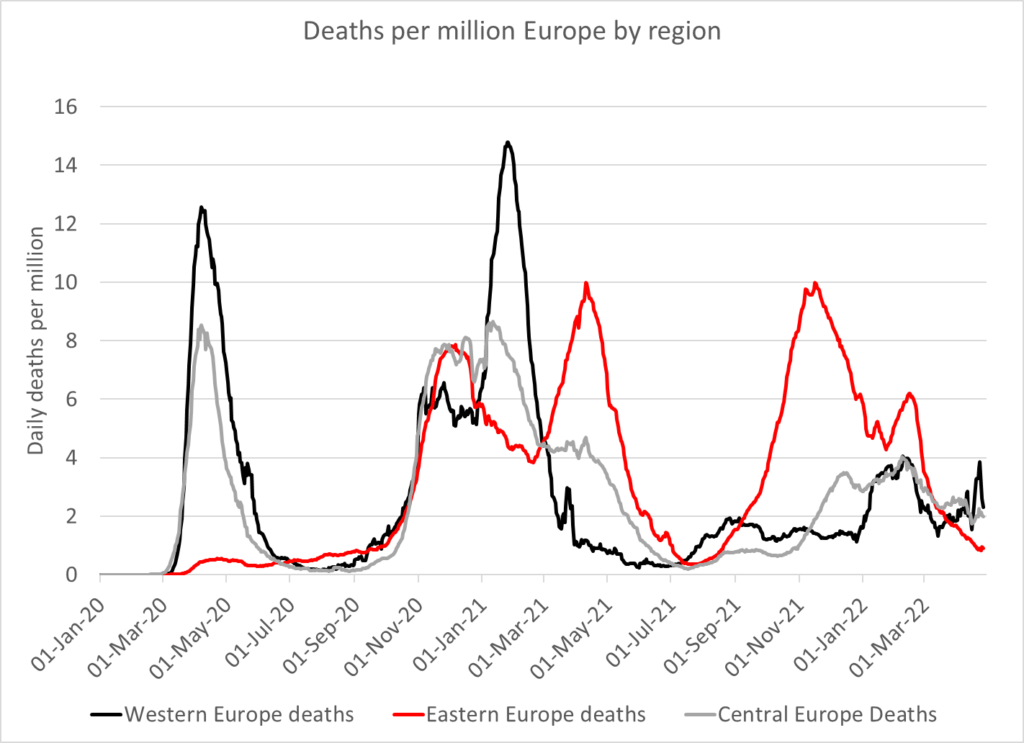
Regions were further divided into countries according to vaccination rates based on data as at 11th April 2021, when Eastern Europe experienced peak deaths. These groupings remained relevant for the course of the epidemic as, at least for Western and Central Europe, there was little distinction between vaccination rates by 17th November 2021.
| Region | Countries | Vaccination rate on 11th April 2021 and range | Vaccination rate on 17th November 2021 and range |
| Western high | Gibraltar, Isle of Man and United Kingdom | 47% (47-100%) | 74% (74-100%) |
| Western low | Faeroe Islands, Iceland, Ireland, Portugal, Spain | 16% (16-17%) | 82% (77-89%) |
| Central high | Malta, Monaco and San Marino | 33% (27-34%) | 82% (68-84%) |
| Central low | All other central European countries | 16% (13-18%) | 74% (60-78%) |
| Eastern high | Hungary and Serbia | 28% (25-30%) | 56% (47-62%) |
| Eastern mod | Cyprus, Finland, Estonia, Greece, Lithuania, Poland, Slovakia | 16% (14-21%) | 56% (22-77%) |
| Eastern low | Belarus, Bulgaria, Kosovo, Latvia, Moldova, Montenegro, North Macedonia, Ukraine | 1.7% (1-6%) | 31% (24-67%) |
Peak deaths in Western Europe in 2020 occurred on 10th April 2020. Peak deaths in Eastern Europe occurred on 11th April 2021. The countries in Western Europe include countries with high vaccine rollout rate e.g. Gibraltar, Isle of Man and United Kingdom and countries with moderate vaccine rollout rates e.g. Faeroe Islands, Iceland, Ireland, Portugal, Spain. On 11th April 2021, 47% of the former group was vaccinated compared to 16% of the latter group. The more heavily vaccinated countries had higher death rates in the Winter 2020/1 wave compared to countries with lower vaccination rates. This relationship reversed in Spring 2021and the overall cumulative mortality was higher for the more heavily vaccinated, compared to the countries with lower vaccination rates (see figure 3a and 3b), and has remained so since the start of 2021.
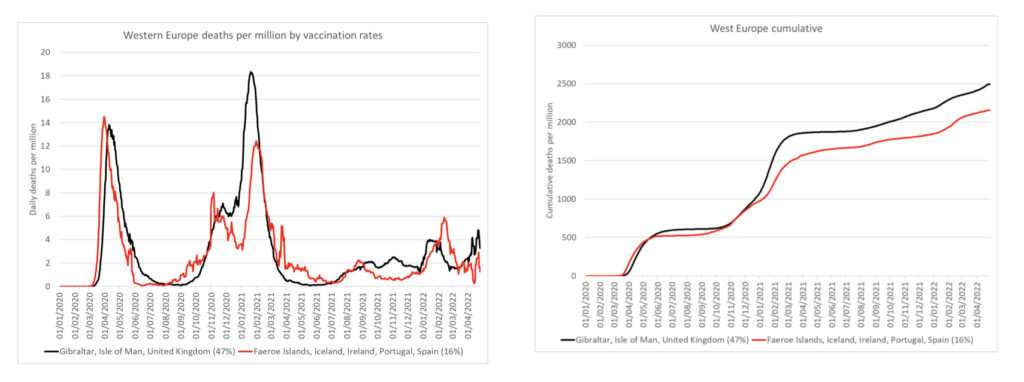
Eastern Europe had vaccination rates on 11th April 2021 ranging from zero to 30%. No data was reported from Albania or Bosnia. Romania and Croatia were omitted as they had intermediate vaccination rates of 11%. For the remaining countries they were grouped into three groups:
- High vaccination rates (28% mean): Hungary and Serbia
- Moderate vaccination rates (16% mean): Cyprus, Finland, Estonia, Greece, Lithuania, Poland, Slovakia
- Low vaccination rates (1.7% mean): Belarus, Bulgaria, Kosovo, Latvia, Moldova, Montenegro, North Macedonia, Ukraine
Comparing these trajectories shows the death rates were again higher in those countries with higher vaccination rollout as at 11th April 2021. By Autumn 2021, the regions with least vaccination had the earliest wave, but the most vaccinated ultimately experienced a wave of similar magnitude in terms of deaths. Again the cumulative mortality was actually highest in the most vaccinated.
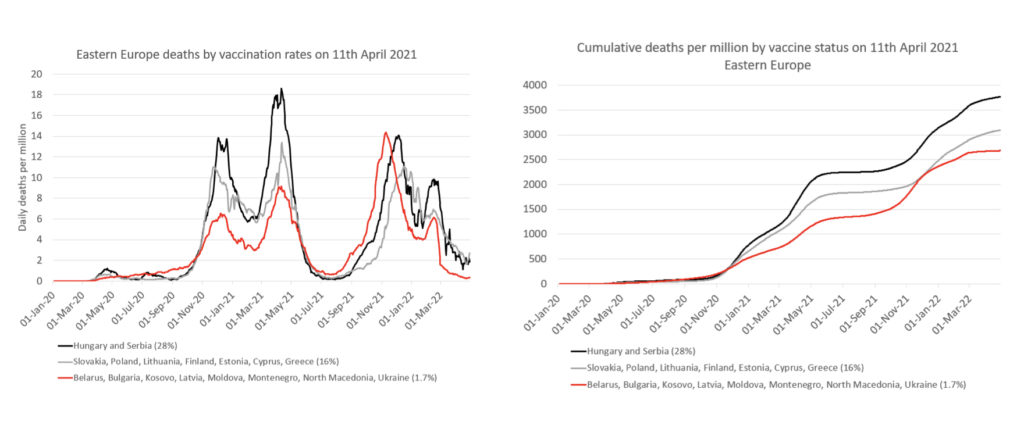
In Central Europe the majority of countries had similar vaccination rates at 16% with the only outliers being Malta, Monaco and San Marino, with rates of 33%. These latter countries have only a small population so extrapolating from them has its limitations, but for completeness the graphs are below. Note that a large part of the difference stems from Spring 2020. From Autumn 2020 until Autumn 2021, the cumulative deaths were similar for both groups before those countries which had had lower vaccination rates overtook death rates.
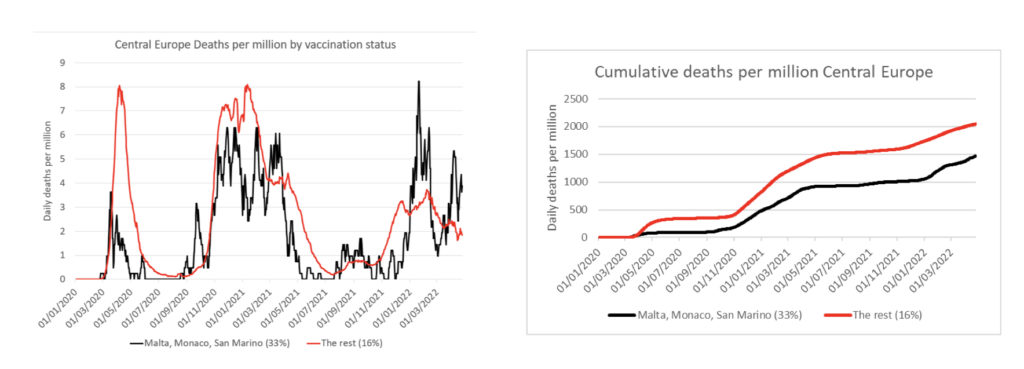
Western European death rates in the 16% vaccinated countries were compared to the death rates in the Eastern European countries with the same vaccination rate in figure 5. The marked difference in Spring 2020, Spring 2021 and Autumn 2021 remains.
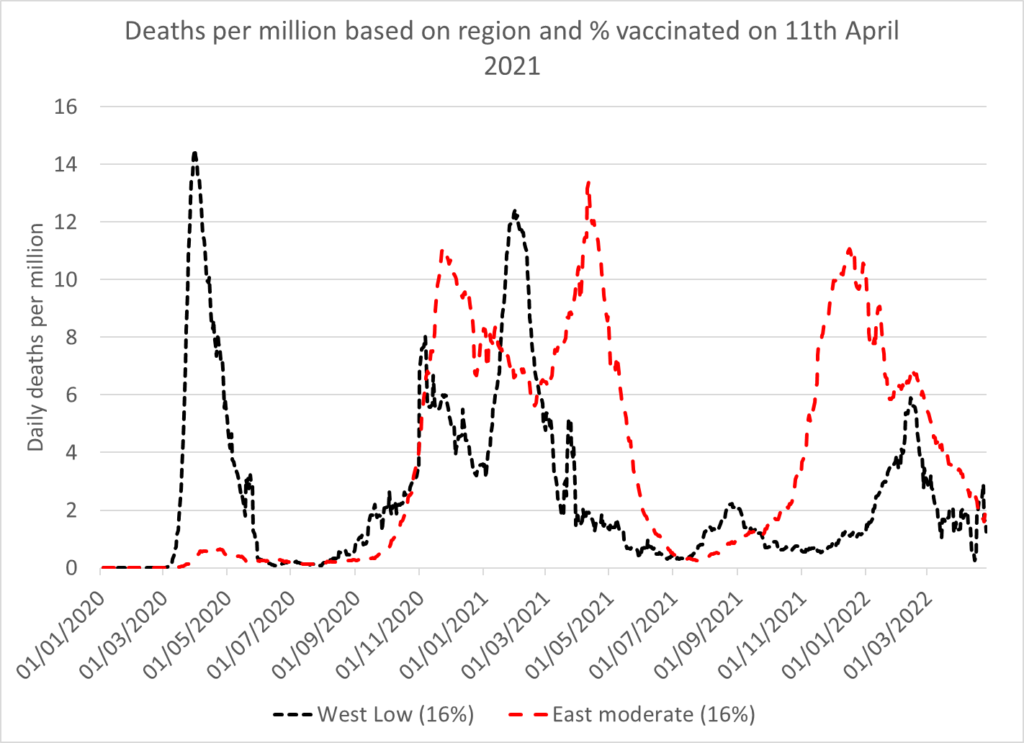
Countries with higher vaccination rates were added in figure 6. For Western Europe these countries had a mean vaccination rate of 47% on 11th April 2021 whereas for Eastern Europe the mean was only 28%. The differences between geographical regions appears to be a much better predictor of death rates than the vaccination rates.

For completeness, countries in Eastern Europe with low vaccination rates (1.7%) were added. Low vaccination does not appear to have had a negative impact overall on death rates. There will be variables that may bias these results including the proportion of the population who are vulnerable and testing rates. However, in the absence of adjustments for these variables the high death rates that might be expected after only minimal vaccination (with effective products) are not apparent.

To enable a full comparison the cumulative deaths per million for each region are presented by vaccination status on 11th April 2021 in Figure 8.
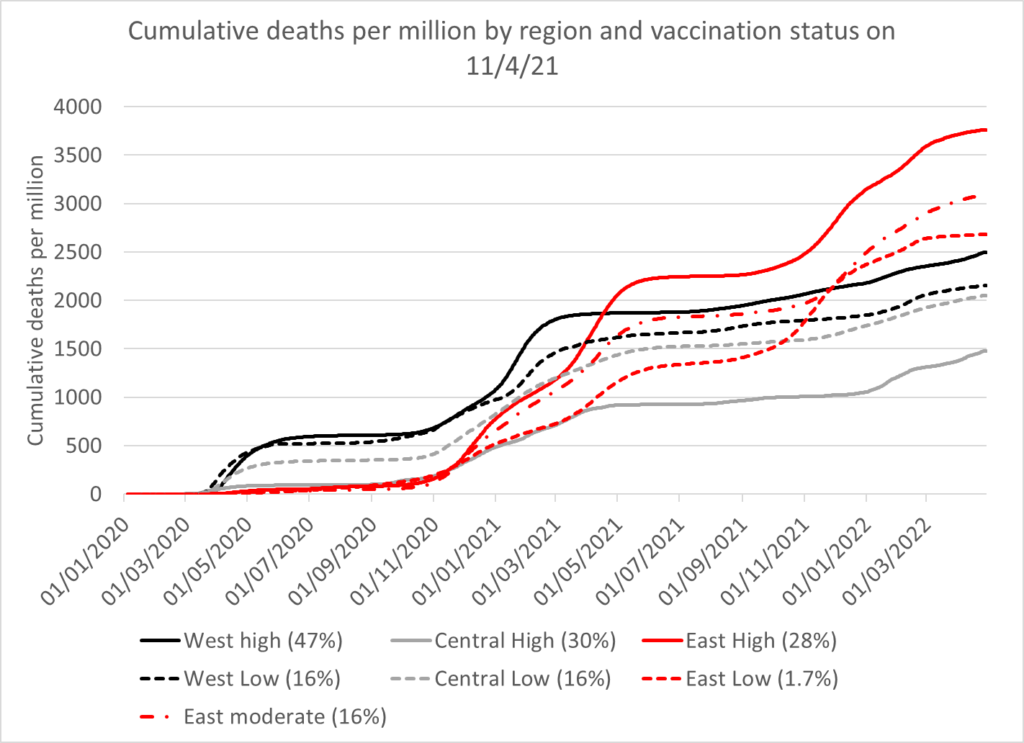
Finally, it must be noted that the comparison in Autumn 2021 of Eastern European countries above is not actually reasonable because the vaccination rates by then had changed considerably from the rates on 11th April 2021. In Western and Central European countries vaccination rates were similar across all countries by Autumn 2021.
A final analysis of those countries based on vaccination rates at peak deaths, 17th November 2021, is therefore warranted and is presented below. Two new groups with vaccination rates above 60% and below 40% were analysed. The former included Cyprus, Estonia, Finland, Greece, Hungary, Latvia, Lithuania (mean 67%) and the latter Albania, Belarus, Bosnia, Bulgaria, Moldova, North Macedonia, Romania, Slovakia, Ukraine (mean 30%). Figure 9 shows how death rates began to deviate from 5th August 2021. Table 2 shows how the vaccination rates for these countries varied over time.
| 11/4/21 | 5/8/21 | 17/11/21 | |
| Cyprus, Estonia, Finland, Greece, Hungary, Latvia, Lithuania | 20% | 57% | 67% |
| Albania, Belarus, Bosnia, Bulgaria, Moldova, North Macedonia, Romania, Slovakia, Ukraine | 4% | 17% | 30% |
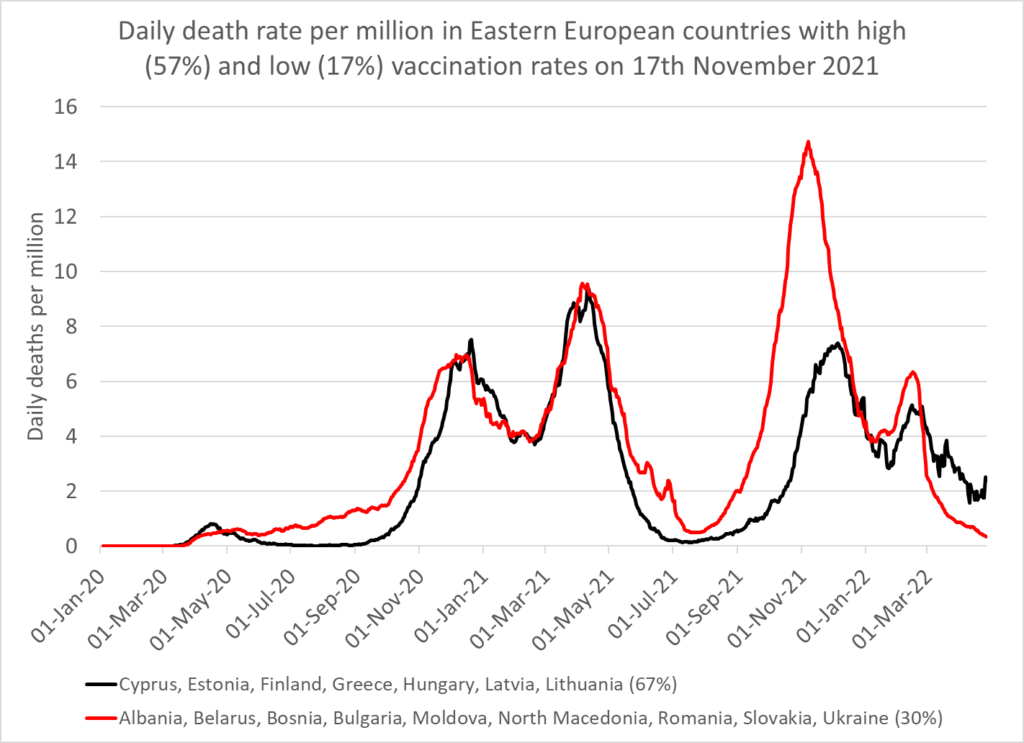
Why was there no significant difference between the 57% and 17% vaccinated countries up until August 2021? Why is the apparent benefit from vaccines seen in Autumn 2021, no longer evident in the last few months?
Conclusion
There are significant differences in the trajectory of covid deaths depending on geographical location. These differences need to be considered when comparing the effect of vaccination between different countries. If vaccinations were the reason for lower deaths in high vaccination rate Western Countries in Spring 2021, then an explanation must be provided for why vaccination apparently did not work in Eastern European countries with a similar vaccination rate. Similarly, why did vaccination fail in Eastern European countries regardless of vaccination rates in Autumn 2021, and yet appears to be working, relative to Western Europe currently?
